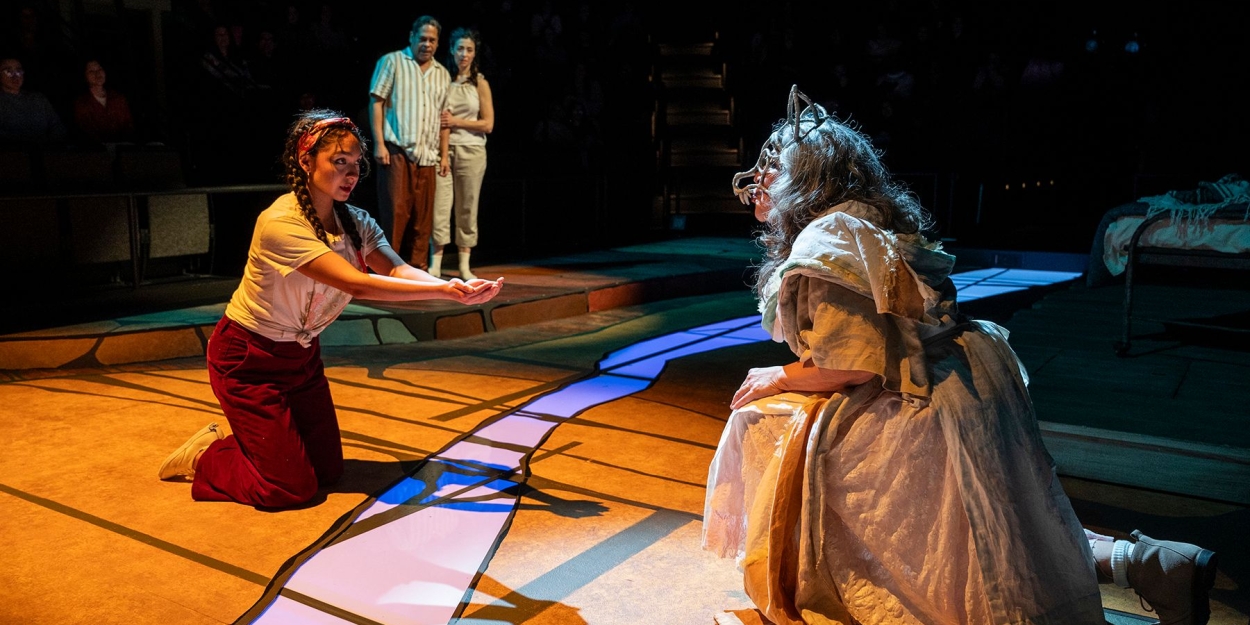Review: A HOME WHAT HOWLS (OR THE HOUSE WHAT WAS RAVINE) at Steppenwolf Theatre
Matthew Paul Olmos's world premiere fable runs through March 2.

In the middle of the 20th century, many Americans cheered the spread of the interstate highway system, one of the most concrete signs of the United States' post-war prosperity and investment in its booming middle class. But what often gets left out of this history of advancement is the story of the countless communities of color that were forcibly relocated as a result of freeway construction. The construction predominantly impacted Black, Hispanic, and Native households that received little, if any, compensation for their relocation. If these communities were allowed to continue living in the shadow of these highways, they and their descendants faced a high risk of developing COPD and dementia resulting from exposure to air pollution. This long-neglected history, and the individual lives at the center of it, forms the basis for Matthew Paul Olmos's newest play, A HOME WHAT HOWLS (OR THE HOUSE WHAT WAS RAVINE). Receiving its world premiere as part of Steppenwolf for Young Adults programming, the production features moving performances and a haunting creative vision that make the most of an often frustrating script. It runs through March 2 at Steppenwolf's in-the-round Ensemble Theater.
A HOME WHAT HOWLS centers on Soledad Vargas (Leslie Sophia Pérez), a young activist and community leader who has moved from rural California to the city. When the play opens, she is preparing to protest proposed urban expansion that would displace her neighbors and loved ones from homes that they have lived in for generations. Meanwhile, back in the countryside, Soledad's mother (Charin Álvarez) and father (Eddie Torres) wait anxiously for the return of their daughter as a circle of ravenous developers and coyotes tightens around them.
Laura Alcalá Baker directs the production with a deft hand, recreating onstage the lyricism inherent in Olmos's text. She seamlessly blends the Vargas family's past, present, and future in a way that gives the play a dreamlike quality that comforts audiences as often as it troubles them. Baker's vision is bolstered by the fluid lighting design of Lindsey Lyddan, and Lauren Nichols's scenic design uses subtle levels and the overlay of what appears to be a topographical map to suggest the numerous locations Soledad moves through on her journey to see her parents again.
Pérez gives a powerful performance as Soledad, perfectly balancing the confidence unique to adolescence with the growing uncertainty of young adulthood. She's at her best when giving voice to these psychological conflicts, particularly when forced to confront Soledad's true motivations for fighting against the maneuvers of the public works department. As Soledad's parents, Álvarez and Torres make for a delightful couple that exudes a warmth and good humor that will have audiences rooting for their success even as the play moves into its perhaps inevitable conclusion.
The remaining ensemble members pull double duty, portraying characters that represent opposing sides of the play's central conflict. Isabel Quintero shines as a mischievous anthropomorphized coyote whose own family was displaced from the land by previous generations of the Vargas family. It's Quintero's playful sneering that reminds viewers that what they're witnessing is more a fable than a naturalistic narrative. Tim Hopper, in a welcome return to the Steppenwolf stage, receives some of the evening's biggest laughs as the public works representative Frank, a satirical take on those well-meaning yet tone-deaf white administrators who praise equity even as their efforts undermine any progress. But Quintero and Hopper also play characters---an older woman allied with Soledad and a mysterious male streetcar conductor, respectively---that exist primarily as plot devices whose purposes have been rendered inscrutable by the script.
Olmos deserves praise for dramatizing a story for young adults that speaks to some of the most pressing issues of our time, namely land rights and the status of racially marginalized communities in the United States. But the script is uneven, the rare play that paradoxically feels too long and too short. Much of the dialogue rehashes the play's central conflict (who deserves land they have claimed from others, human or otherwise?) in ways that feel redundant, as though the playwright is worried young viewers won't be able to tease out the play's themes on their own. But then the play's stunning final revelation comes too suddenly, ending on a groundlessly hopeful note that feels unearned and unfulfilling.
As frustrating as these elements may be, there's no denying that A HOME WHAT HOWLS will teach young audiences about historical developments whose effects our nation is still grappling with all these decades later. Better yet, these lessons are delivered with the help of an undeniably captivating cast and creative team.
Photo Credit: Michael Brosilow
Reader Reviews

Videos

